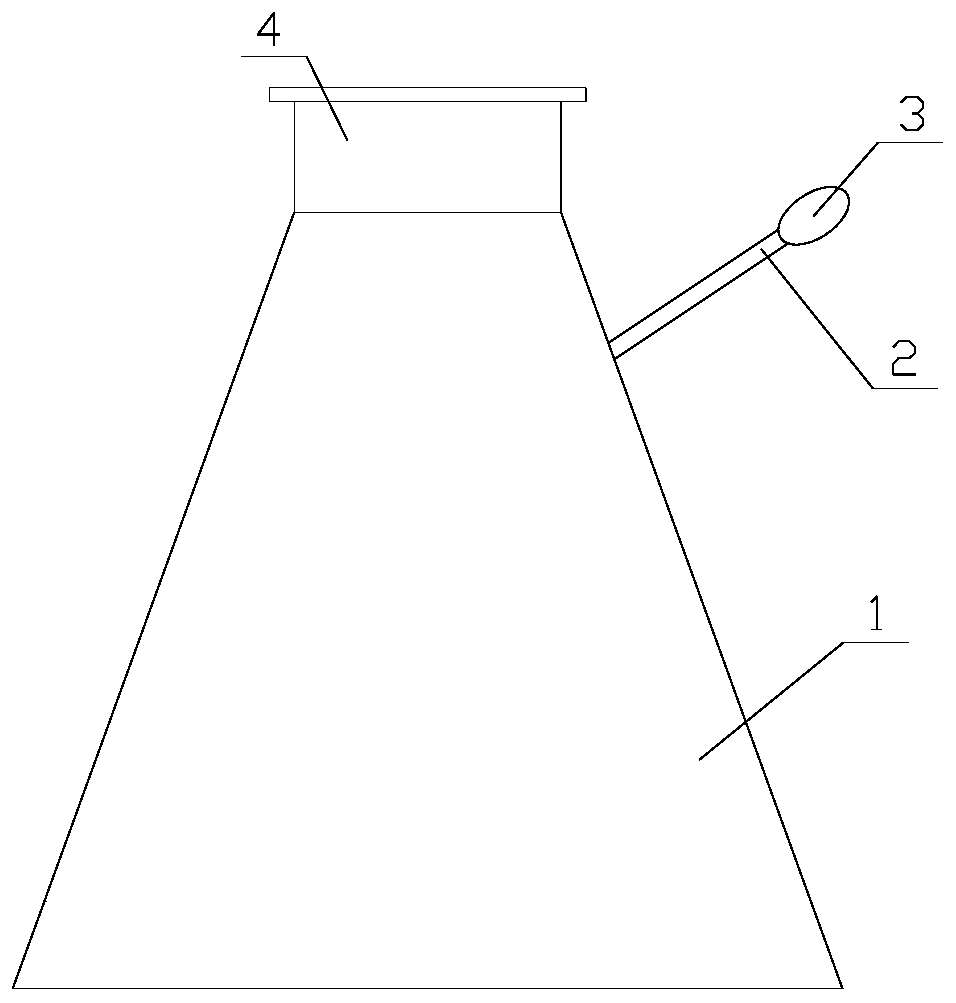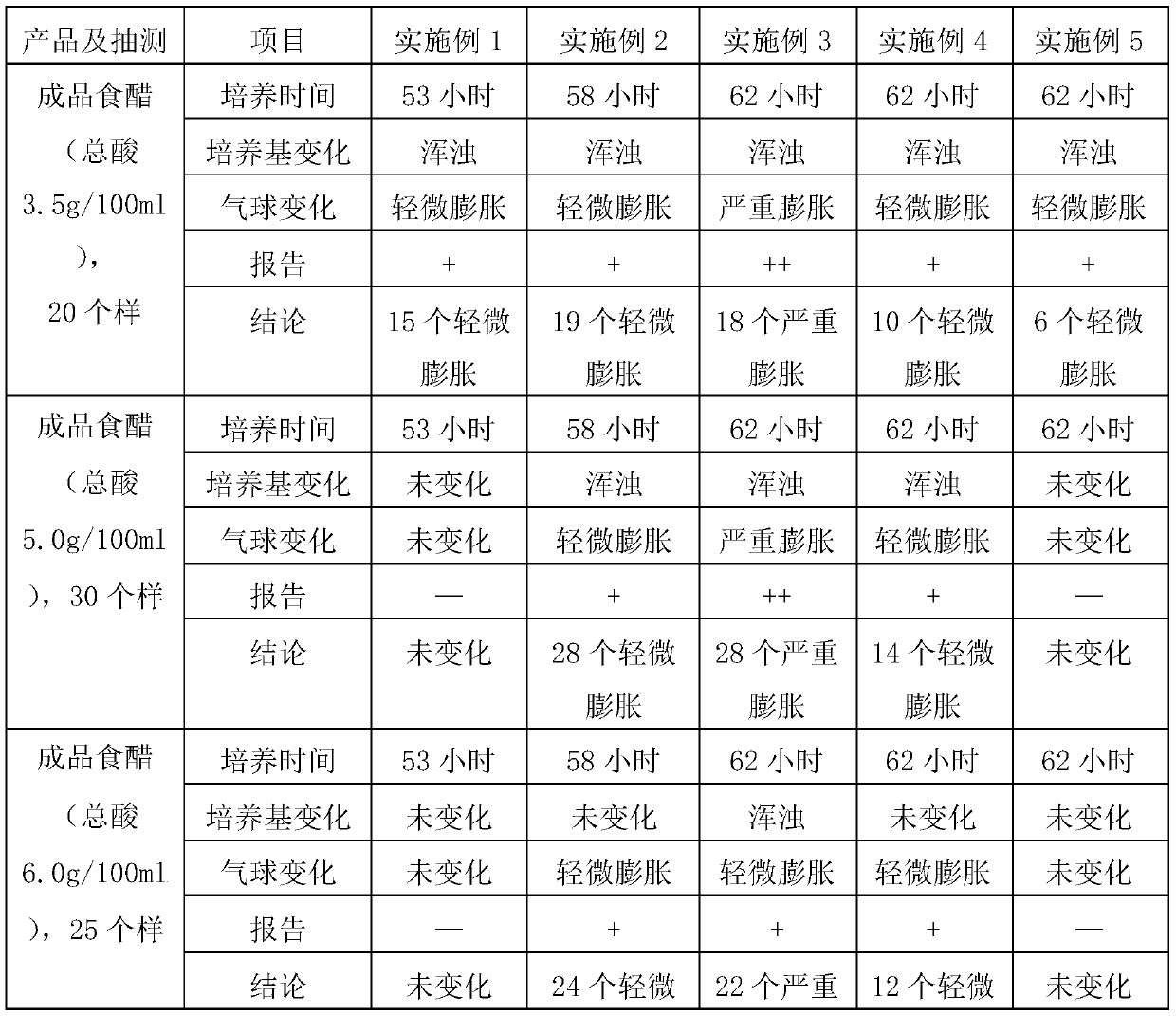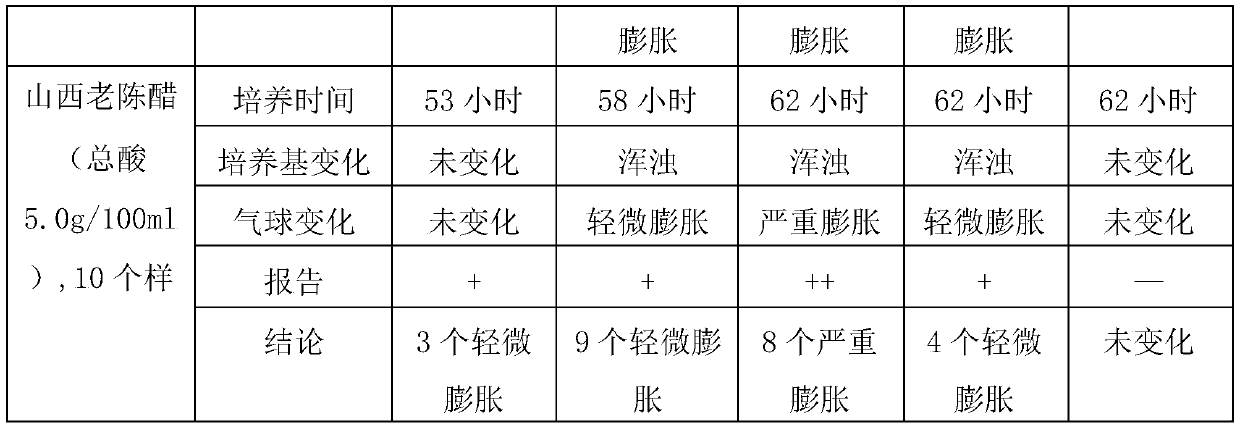Method for detecting gas-producing acidophilic bacteria in vinegar
A detection method, acidophilic bacteria technology, applied in the direction of biochemical equipment and methods, microbial measurement/inspection, etc., can solve the problems of bulging bottles, vinegar bags, etc., achieve low detection cost, accelerate the speed of acid and gas production , Accelerate the effect of acid and gas production
- Summary
- Abstract
- Description
- Claims
- Application Information
AI Technical Summary
Problems solved by technology
Method used
Image
Examples
Embodiment 1
[0035] like figure 1 Shown, the detection method of aerogenous acidophilus in a kind of vinegar of the present invention comprises the following steps.
[0036] 1. Composition of the culture medium: 400ml / L of solid vinegar fermented in the pool for 1 day (provide the trace acid, sugar, and wine required for cultivation, so that its components are close to those contained in the finished vinegar stock solution) 400ml / L (total acid 0.3g / 100ml, reducing sugar 7%, PH5.5, alcohol 2%), glucose 10g / L, peptone 5g / L, fresh milk 30g / L, citric acid 1g / L, dipotassium hydrogen phosphate 2g / L, ammonium citrate 8g / L, sodium acetate 5g / L, magnesium sulfate heptahydrate 7g / L, Tween 80 1ml / L, the rest is water, pH6.0.
[0037] 2. Packing of culture medium
[0038] Dispense 180ml of culture medium into small-mouth retort bottle 1, cover the mouth of the bottle tightly with a silica gel stopper, sterilize at 121°C for 25min, and cool for later use.
[0039] 3. Vaccination
[0040] Under a ...
Embodiment 2
[0047] like figure 1 Shown, the detection method of aerogenous acidophilus in a kind of vinegar of the present invention comprises the following steps.
[0048] 1. Composition of the culture medium: 500ml / L of solid vinegar fermented in the tank for 2 days (provide the trace acid, sugar, and wine required for cultivation, so that its components are close to those contained in the finished vinegar stock solution) 500ml / L (total acid 0.4g / 100ml, reducing sugar 8%, PH6, alcohol 3%), glucose 13g / L, peptone 8g / L, fresh milk 40g / L, citric acid 2g / L, dipotassium hydrogen phosphate 2g / L, ammonium citrate 7g / L , sodium acetate 4g / L, magnesium sulfate heptahydrate 5g / L, Tween 80 1ml / L, the rest is water, pH5.0.
[0049] 2. Packing of culture medium
[0050] Divide 180ml of the culture medium into small-mouth retort bottles, cover the mouth of the bottle tightly with a silica gel stopper, sterilize at 121°C for 25 minutes, and cool for later use.
[0051] 3. Vaccination
[0052] Und...
Embodiment 3
[0057] like figure 1 Shown, the detection method of aerogenous acidophilus in a kind of vinegar of the present invention comprises the following steps.
[0058] 1. Composition of the culture medium: 600ml / L of fermented liquid of solid vinegar in the pond for 3 days (provide the trace acid, sugar, and wine required for cultivation, so that its components are close to those contained in the stock solution of finished vinegar) 600ml / L (total acid 0.5g / 100ml, reducing sugar 10%, PH7, alcohol 4%), glucose 15g / L, peptone 10g / L, fresh milk 50g / L, citric acid 3g / L, dipotassium hydrogen phosphate 1g / L, ammonium citrate 6g / L , sodium acetate 3g / L, magnesium sulfate heptahydrate 4g / L, Tween 80 1ml / L, the rest is water, pH4.0.
[0059] 2. Packing of culture medium
[0060] Divide 180ml of the culture medium into small-mouth retort bottles, cover the mouth of the bottle tightly with a silica gel stopper, sterilize at 121°C for 25 minutes, and cool for later use.
[0061] 3. Vaccinatio...
PUM
 Login to View More
Login to View More Abstract
Description
Claims
Application Information
 Login to View More
Login to View More - R&D
- Intellectual Property
- Life Sciences
- Materials
- Tech Scout
- Unparalleled Data Quality
- Higher Quality Content
- 60% Fewer Hallucinations
Browse by: Latest US Patents, China's latest patents, Technical Efficacy Thesaurus, Application Domain, Technology Topic, Popular Technical Reports.
© 2025 PatSnap. All rights reserved.Legal|Privacy policy|Modern Slavery Act Transparency Statement|Sitemap|About US| Contact US: help@patsnap.com



